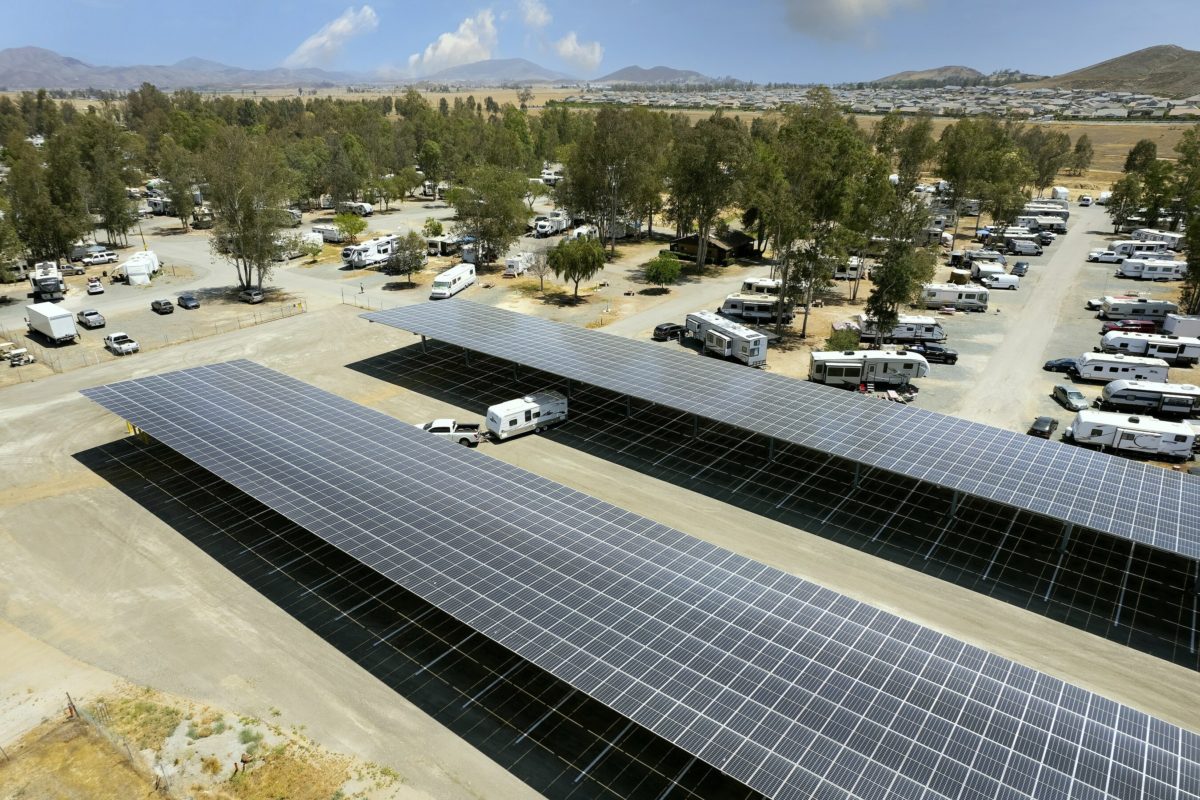DSD Renewables and Black Bear Energy announced the completion of a 1.5 MW solar project in Menifee, California, at the Wilderness Lakes campground. Built for Thousand Trails, a recreational vehicle resort company, the solar arrays are mounted atop parking canopies.
The facility is expected to generate 2.4 million kWh of energy annually, meeting about 50% of total energy use across the campground. The facility has over 500 RV campsites and a common area with a swimming pool, hot tubs, clubhouse, fitness center, and game room.
The 3,500 panel array is mounted on carports designed for rigs ranging 30 feet to 45 feet in length, covering 82,000 square feet in total. Month-to-month sites are shaded by the array, which also powers the controlled access gates and security cameras.
“We’re thrilled to have a high-end amenity for guests and members that also highlights our ongoing focus on sustainability, renewable energy and environmental awareness,” said Monica Ferrer, senior director of energy and sustainability for Thousand Trails.
Solar carports
The U.S. has roughly two billion parking spots. If 25% of parking spots were outfit with 2.88 kWdc per spot, the capacity of those 500 million parking spots would total 1.44 TW.
Assuming a lower-than-average generation capacity factor of 15% due to sub-optimal angling of the panels, these solarized parking spots would generate 1.89 petawatt hours (PWh) of electricity. The total electrical consumption of the US is currently around 4 PWh per year.
In late 2022, California Senator Josh Becker (D-San Mateo) submitted a new piece of legislation with a goal to motivate solar carport installations in California via a tax incentive. The bill, SB 49, states intent to, “provide tax incentives for the construction of solar canopies over large parking lots to boost the local generation of clean electricity in urban and suburban areas while reducing the need for dedicated land in rural areas and transmission to deliver the clean energy into population centers.”
Senator Becker’s press release notes that, “pavement makes up 35%-50% of the total surface area in cities, and 40% of that pavement is parking lots.” It also cites California-specific solar carport figures.
For example, Los Angeles County has 101 square miles of parking lots, and contains about 25% of the state’s population. The press release extrapolates these numbers by population, inferring that there should be approximately 400 square miles of parking lots in the state, equivalent to 26 GW of solar canopies.
The senator also notes that California’s energy agencies estimate that the state needs about 110 GW of new solar power to meet its 100% clean energy target by 2045. An analysis by Yale University suggests that carports in the state could meet about one-third of the state’s electricity demand.
Some states have already put in place incentives for solar carports, offsetting the additional costs of steel, installation and grid connection. These additional costs would normally add as much as $1 per watt versus the price of a typical commercial rooftop installation. Massachusetts’ SMART program, for instance, offers a $0.06 per kWh incentive for 20 years for solar canopies.
(Read: “Off-grid solar plus storage EV ARC systems to be deployed by Puerto Rico government agencies”)
Built-environment PV projects like carports and highway-side vertical PV are increasingly growing in popularity in Europe. In late 2022, France passed a law that makes solar carports mandatory for all parking lots greater than 1,500 square meters.
This content is protected by copyright and may not be reused. If you want to cooperate with us and would like to reuse some of our content, please contact: editors@pv-magazine.com.









By submitting this form you agree to pv magazine using your data for the purposes of publishing your comment.
Your personal data will only be disclosed or otherwise transmitted to third parties for the purposes of spam filtering or if this is necessary for technical maintenance of the website. Any other transfer to third parties will not take place unless this is justified on the basis of applicable data protection regulations or if pv magazine is legally obliged to do so.
You may revoke this consent at any time with effect for the future, in which case your personal data will be deleted immediately. Otherwise, your data will be deleted if pv magazine has processed your request or the purpose of data storage is fulfilled.
Further information on data privacy can be found in our Data Protection Policy.